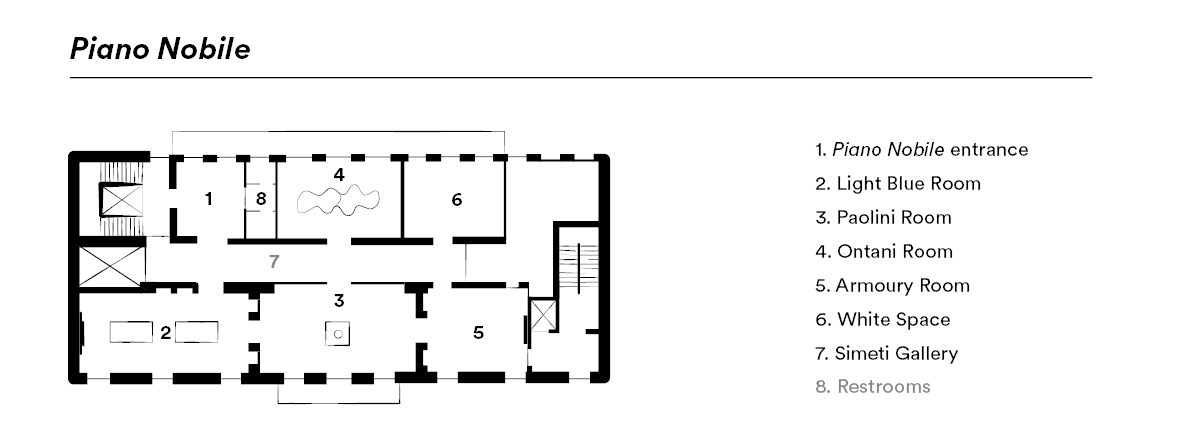The history of palazzo
History
The Museum of Art of the Fondazione Luigi Rovati is housed at no. 52 Corso Venezia, in an historic Milanese Palazzo across from the gardens of Via Palestro.
Eighteenth-century sources refer to area as the “Borghetto di Porta Orientale”, or “Eastern Gate Quarter”, a name still echoed by that of a street which runs alongside the Museum’s block. Numerous authors of the period considered the zone to be one of the city’s most disreputable, with Manzoni describing it as a spot where those who carried away corpses during the plague would gather. It was also in the eighteenth century that a new project for reorganizing the area, starting from the portico, got underway. A pebbled path to the garden was laid, perimeter walls were built, and the silo was transformed into a dry well with a cistern.
In 1836, the Englishman Giacomo Johnson purchased the land, establishing a workshop for the production of pressed-metal buttons and crests, as shown by some bronze buttons discovered during excavation of the surface level. When the founder passed away, the business was continued by his son Stefano, who shifted the focus to producing medals while changing the name of the company to "Stefano Johnson – Medal Factory".
In 1871, the Prince of Piombino built the current Palazzo, after having earlier structures leveled and covered over.
The building later becomes the property of Donna Javanotte Manca di Villahermosa, the widow of Senator Ettore Bocconi. In 1958, then it was sold to Giuseppina Rizzoli.
The most significant restructuring and renovation work was commissioned in 1960 by the new owners, the Rizzoli family, who engaged two architects: Ferdinando Reggiori, a former archaeologist responsible for the restoration of the Poldi Pezzoli museum-home, and Filippo Perego, a specialist in the restoration of venerable palazzos and villas. The former modified the building’s morphology, redesigning the internal façade, while the latter handled the revival of the interior decorations, restoring the Palazzo’s nineteenth-century identity while also doing certain rooms in a contemporary fashion.
In 2016, by which time the Palazzo was no longer inhabited, the Fondazione assigned the new restoration project to the firm MCA, led by architect Mario Cucinella.
Following the renovation, in 2024 Fondazione Luigi Rovati was awarded the Compasso d'Oro ADI, one of the most prestigious national and international design prizes, in the "Exhibition design" category.
Project
 |
The architectural project realised the Fondazione's request for a modern museum: it envisages two newly-built underground floors to host the hypogeum exhibition, the Museum’s collection storage and technological systems.
The façade, protected by historic landmark status, was to be preserved, while the body of the Palazzo underwent a thoroughgoing transformation, in light of the Foundation’s aims. In particular, the belowground floors were enlarged, so as to be able to install both a “Hypogeum” level for exhibition purposes and another floor earmarked for storage of the collection and the installation of technological systems. The second aboveground floor, a continuation of the exhibition layout, stays true to the Palazzo’s spirit and style: the floors, ceilings and furnishings underwent a major restoration and preservation effort. The building’s other floors house functions tied to museum activities: offices, a study room, conference rooms, spaces for temporary exhibitions, the museum shop, the café-bistro and the restaurant. The large entry lobby on the ground floor serves as a distribution space leading to the ticket office, the museum shop, the café-bistro, as well as the entryway to the gourmet restaurant found on the top floor, plus the garden and its exhibition pavilion.
The restoration of the garden, subject to historic landscaping restrictions, preserved the original species of trees and shrubs, harmoniously introducing new varieties of plants and vegetables typical of Piermarini’s Milanese garden landscapes.
The Pavilion, once the greenhouse and storage shed for garden ornaments, has been completely renovated and restructured as an exhibition space.
All the design work focussed significant attention on environmental sustainability and energy efficiency, in terms of both plant-engineering systems and the materials chosen, as the building satisfied the certification parameters of the LEED protocol.
The technological infrastructure and digital services were designed on the basis of a system - the first of its kind - that integrates information tied to the visitors’ experience with that related to the governance of the museum, all on a single platform. |
Maps











